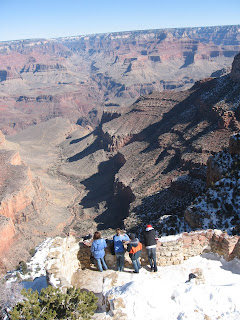February is a good month for cooking adventures. From squashes to apples, potatoes to cabbage, winter-time is keepin' us busier than ever at the market and the produce is begging for experimentations of all kinds. I gotta say, my favorite so far is
this incredible squash bake that I think I ate almost two entire batches of. De. Lic. Ious. Stop reading, and go buy a butternut squash and do this immediately.
Not that there haven't been some major set-backs (my giant "roast of root vegetables" did not go so hot and I'm too prideful to ask around at the market where I went wrong... how hard can a root roast melody be? They'll all laugh and point at me!).
And some things magically come out well despite the fact that you brazenly look at the recipe and think, "I don't have ingredient A, D, and F, and I'm gonna wing it!" Enter my Accidental Muesli.
In an attempt to make
this incredible sounding power bar with only the things we could find offhand in my mom's kitchen, we ended up not with powerbars, but a crunchy sweet muesli. Which will come in handy when my bro and I take off for Arizona and la canyon grand cette week-end. I've been munching on it all week with yogurt and mixed it into my oatmeal... horray for experiments that go wrong in all the right ways!!
Accidental Muesli
Around 1 cup dried coconut
1 1/2 cup rolled oats
1 cup bran flakes cereal
1 cup pecans
1/2 cup pumpkin seeds
1/4 cup brown sugar
1 cup slivered almonds
1 cup maple syrup
1 tsp salt
1 tsp vanilla
1 cup raisins
Per
Heidi's instructions on her site, we toasted the nuts and coconut on a cookie rack at 350F. Just until the coconut was nice and brown which was under 10 minutes with my mom's spiffy oven. Placing all the nuts and coconut in a mixing bowl and adding in the rolled oats, we moved over to the stove and poured the maple syrup, sugar, salt, and vanilla in a deep pot and brought it to a boil while stirring constantly.
At this point we are munching on the toasted coconut and nuts. Again I repeat, toasted coconut is food of the gods. De. Lic. Ious.
After bringing the maple syrup to a rolling boil, we poured the sauce over the nuts and stirred to incorporate fully. I then attempted to press the mixture into a pyrex dish to set into bars but foud that my mixture was much too flaky and sticky...
So flaky.
So sweet.
So nutty.
So totally wonderfully granola-y that you'll be picking and pouring into yogurt, stashing in your car for a rush-hour snack, or putting over pancakes.


 the canyon walls - if we don't fall in love with it enough to preserve and protect it... who will?If we don't enrich our lives by seeing the vastness of the American landscape, how will that change the America we give over to the next generation? What will be lost? Are we bringing up a generation who will value nature and understand their place within it? What's at stake?
the canyon walls - if we don't fall in love with it enough to preserve and protect it... who will?If we don't enrich our lives by seeing the vastness of the American landscape, how will that change the America we give over to the next generation? What will be lost? Are we bringing up a generation who will value nature and understand their place within it? What's at stake?

